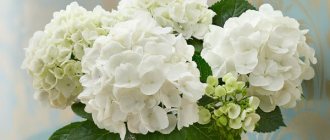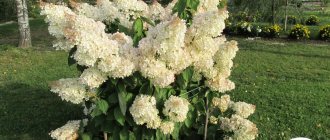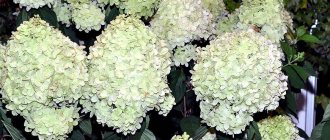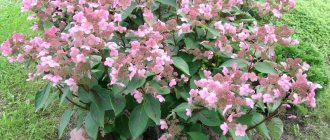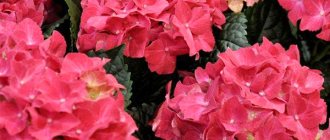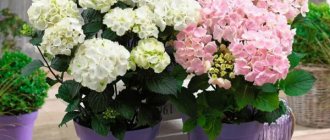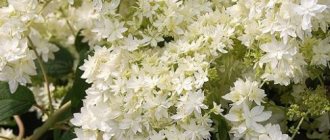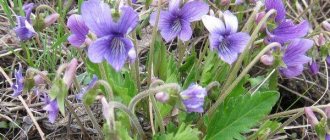Description of culture
Hydrangea is a perennial shrub that has high decorative properties. A lush crown with bright large inflorescences during the flowering period looks impressive in flower beds and imitation barriers. Large leaf hydrangea or hydrangia is a very moisture-loving plant. The family includes several dozen varieties that differ from each other not only in decorative characteristics, but also in their care and sensitivity to weather conditions.
Frost-resistant varieties
The most popular frost-resistant varieties:
- Nikko blue. The shrub is quite low-growing. By the way, it can be grown both outdoors and on the windowsill of an apartment. Characterized by large blue inflorescences. The foliage has a bright green color. In open ground, the shrub can reach 1.5 meters in height. The amazing ability to change the color of flowers is a pleasant surprise for gardeners. Color saturation can vary from light blue to bright blue. This factor directly depends on the composition of the soil. The more acidic the soil, the richer the color.
- Miss Saori is a new generation large leaf hydrangea. This variety was bred several years ago and has already earned popularity among designers and amateur gardeners. In winter it can withstand temperatures down to -26 degrees. It is distinguished by a unique color: creamy flowers have a bright pink edging along the edge. The foliage has a bluish tint. Inflorescences cover almost the entire crown of the plant from June to August. The low-growing shrub is suitable for growing in pots.
- Masya. This is a remontant variety. Flowering takes place in two stages: from June to November with a short break in the middle of the cycle. The bush is quite large - up to 1.5 meters with spreading long shoots. As a rule, it requires a garter. A special feature of the variety is its abundant flowering. And the size of the inflorescence can reach 30 cm in diameter. The bright crimson flowers have a jagged edge, creating an imitation of lace. This variety is also dependent on the soil, so to obtain the necessary color saturation it is worth adjusting the acidity of the soil.
- Endlys Samme. A unique variety that blooms continuously from June to November. Hydrangea does not have outstanding decorative characteristics. The inflorescences are medium in size. The color may be blue or pink depending on the composition of the soil. But its ability to renew flowers every 5-6 weeks is impressive and attracts gardeners.
- Romance Pink is another representative of frost-resistant hydrangeas. It is distinguished by its rapid growth and original flower shape. However, the plant blooms for a short time. The flowering period lasts only a few weeks.
- Tugese is an amazing variety. It can be called a rainbow. In June, greenish inflorescences appear on the bush, which are replaced by a whole palette of colors, depending on weather conditions and soil composition. Probably no other plant can boast such a palette of colors.
Species requiring shelter
- Sybil. This is a small shrub up to 1 meter high. It has high decorative properties. Its inflorescences are gigantic in size. The flowers are painted pink-red and have a special glossy coating.
- Hot Red is a red hydrangea. The decorative properties probably end there. The inflorescences of the plant do not exceed 15 cm, and the lush bush is characterized by low growth.
- Renata Steiniger. Hydrangea of this variety has characteristic blue inflorescences. The shrub is tall, which allows it to be used as a flowering hedge.
Hydrangea is a shrub that grows naturally in Japan, southern China and some tropical islands. This fact explains the thermophilic nature of the culture. It is worth remembering that covering the plant should be done with special care.
General description of the bush
Although hydrangea is sometimes cultivated as a tree by inexperienced gardeners, it is a bush. Botanical features:
- Ovate leaves.
- The flowers are large, have 4 sepals, resembling petals. The color can be anything, from snow-white and blood-red to amazing blue, lilac, and greenish.
- Some types of hydrangeas can be cultivated as trees.
- In nature, the height reaches 3 meters, but in gardens and personal plots the height rarely exceeds 1.5 meters.
Popular articles Hydrangea paniculata: autumn care and preparation for winter
Paniculata hydrangea is the most popular and unpretentious variety of flower
In the natural environment, a large number of different varieties of hydrangea are found in China, Japan, and other Asian countries. The plant prefers light partial shade and a normal level of humidity - a dry climate is destructive for them.
Note! The tree-like hydrangea is considered the most unpretentious, capable of growing in the climate of the middle zone and characterized by high growth rates.
Landing rules
The time for planting hydrangeas in open ground is chosen according to the weather conditions of the region. If planting is carried out in cold northern regions, then it is better to carry out this procedure in the spring, then the seedling will have time to fully take root before the onset of winter.
In regions with a temperate climate, you can plant the plant both in spring (from mid-April to mid-May) and in autumn (from early September to mid-November)
When planting in autumn, it is important to have time to place the plant in the ground 3 weeks before frost, so that it has time to adapt and does not die when the temperature drops for the first time.
Growing conditions
Hydrangea is planted in well-lit or semi-shaded areas. For adequate plant development, the soil must be acidic and well-drained. Sandy loam or fertile soils are ideal
When choosing a site for planting, you should pay attention to the fact that the plant is not located in a flooded area during periods of snowmelt or rain, otherwise the root collar may be subject to fungal infection or rot.
The area for planting is prepared in the autumn. To do this, the area is cleared of remnants of vegetation, and the soil is dug up to a depth of 40 cm. For every 1 m², 5 kg of humus, 10 kg of peat and 10 kg of river sand are added. During the winter period, the soil will become looser and more moisture-permeable.
Important! You should not plant hydrangea near tall trees, otherwise large trees will absorb all the moisture when watering.
Instructions for planting hydrangeas in open ground:
- Dig a hole 40 cm deep and 30 cm wide.
- Mix the top fertile layer of soil with 10 kg of peat, 10 kg of sand, 5 kg of humus, 30 g of superphosphate.
- Place a layer of drainage (expanded clay, brick fragments, gravel) 5 cm high at the bottom of the hole.
- To the middle of the hole volume, the previously prepared substrate is added on top of the drainage base.
- The seedling is introduced into the hole and the rhizome is carefully spread over the mound of soil.
- Add soil to the top of the hole and compact it tightly.
- Water the plant with 5 liters of water and mulch with peat.
Landing Features
The main aspect of growing hydrangea is the correct choice of soil and regular watering. The shrub loves nutritious soils, so planting is always accompanied by the addition of humus or peat mixtures. To preserve the varietal characteristics of the crop, it is necessary to maintain optimal acidity. Calcareous soils are not recommended because hydrangeas will die over time in such conditions.
The plant prefers partial shade. Planting in open space is fraught with the production of small inflorescences, and in the shade - late flowering. In the garden you need to find a place away from trees. Neighborhood with large crops can lead to moisture deficiency.
Planting occurs in the spring, when frost is already excluded. The soil must be mulched; pine sawdust is suitable for this. And, of course, abundant watering is important.
Care
To ensure the most comfortable conditions for the growth and development of Schloss Wackerbart hydrangea, it is necessary to water it in time, feed it, loosen it and carry out sanitary and formative pruning. And you also need to remember to prepare the bush for winter.
Did you know? In Japan, the hydrangea flower is considered a symbol of sincerity of feelings and the manifestation of special cordiality.
How does hydrangea overwinter?
Around mid-August, when the last fertilizing is applied, the Schloss Wackerbart hydrangea begins to enter a dormant state. At this time, you need to stop watering it so that new flower buds begin to form. All dried inflorescences are cut off so that energy is not wasted on them.
Since this variety does not tolerate low temperatures and does not survive frosts below -18°C, it is necessary to take care of how the bushes will winter. To do this, they are hilled to a height of about 30 cm and the soil under them is covered with peat, sawdust, leaves or grass.
In northern regions with fairly severe winters, hydrangea needs more serious preparation for wintering. In the fall, before the cold weather sets in, it is necessary to cut off all the leaves, leaving only a few on top of each shoot. This will help the young branches become woody as soon as possible and prepare for the cold. 1 - inclined shoots, 2 - hilling, 3 - spruce branches, 4 - lutrasil, 5 - stone Branches that did not have an ovary can be shortened by half. After this, the plant is bent to the ground, near the roots it is covered with spruce branches, and where the tops are covered with conifers, peat is poured into the center of the bush. Then this entire structure is wrapped in roofing felt. Such protection, as a rule, can protect bushes even from severe frosts.
Watering and loosening
After planting, you need to water the hydrangea well so that its root system takes root in the new place and begins to grow. Subsequent watering in warmer months should be done once a week. 1-2 buckets of water for each bush will be enough. If it rains often, you can water less often.
The water must be settled, because hydrangea does not tolerate the presence of lime in the soil, which gets there with tap water. You can also use rain water, it has an excellent composition.
Loosening the soil around the plant must be done at least 2 times during the summer to better retain moisture and remove weeds that interfere with normal growth and development. You need to loosen it no deeper than 5–6 cm. For even better results, it is advisable to mulch the soil under the bushes with peat, sawdust or dry grass.
Top dressing
To improve the appearance of the plant and help it bloom long and profusely, it is necessary to add fertilizers containing the necessary nutrients to the soil. Wackerbart Castle hydrangea is fertilized 3 times per season.
Feeding is usually carried out according to the following scheme:
- in the spring, before growth begins, urea is added in the amount of 20 g per area of 1 m², as well as about 40 g of potassium sulfate;
- during the appearance of buds, the plant needs to be fertilized with potassium and phosphorus fertilizers, which are included in a special complex developed for flowering shrubs;
- in the middle and end of summer, two more feedings are carried out, the same as in early spring, to provide the hydrangea with a supply of necessary substances for growth and flowering next year.
The last time of the year, fertilizers are applied no later than mid-August, and then the plant does not need feeding, because it should gradually enter a dormant state.
Trimming
All varieties of large-leaved hydrangea require virtually no pruning. It is not recommended to remove old shoots, unlike other species, because in this case the plant will not bloom.
The main thing is not to forget to carry out sanitary pruning, during which you must remove all dry, diseased and damaged branches. And, of course, it is imperative to remove all inflorescences, but only after they have completely dried out.
Preparing for winter
The winter period provides an opportunity for any representative of the flora to gain strength for the next lush flowering for a long time. In the summer, hydrangea will thank you with lush, spectacular blooms for taking care of it in the winter. So, winter care involves performing some mandatory tasks. For indoor hydrangea this is:
- pruning;
- transfer.
Hydrangea paniculata and tree-like - differences
For garden hydrangea, some features are taken into account. Here it is important to prepare the site in advance and think through all the nuances. Regarding the soil, you need to choose a place with sufficient moisture and lighting, depending on the variety (light-loving, shade-tolerant). The best place to grow hydrangea is considered to be partial shade, so that the bushes feel comfortable. Growing conditions must correspond to the natural properties of the bush.
Sanitary cleaning of bushes
This event is carried out after flowering to preserve its decorative appeal. When pruning, all weak small shoots are removed, leaving strong ones, which must be shortened by half their length. The shrub sheds its leaves after summer, this is the natural preparation of the plant for a long winter dormant period. To increase frost resistance under the bushes, you need to collect all fallen dried leaves and destroy them. This promotes lignification of young shoots. Before the onset of frost, the last leaves are removed from the bushes. The very top ones are left, which will protect the flower buds.
Important! Covering the bushes with any materials, even dry leaves, helps keep hydrangeas alive in winter. You can save the buds by bending the tops of the bushes to the ground. The branches do not suffer in this case due to their flexibility.
Colorful inflorescences enliven landscape design
Transfer
The hole is prepared with a size of 40x40 cm. When growing in groups, planting is carried out at a distance of bushes from each other up to 1 m. A well-mixed mixture of earth with sand and fertilizers is immersed in the bottom of the hole. A small peat layer and a drainage layer using expanded clay or pebbles are poured on top.
Hilling the base of the bushes with a dry layer of soil, as well as mulching, where dry leaves are used as mulch, have a positive effect.
Thus, there is nothing difficult in growing red hydrangeas. The main thing is to choose a variety suitable for the climate, plant it correctly, provide it with watering and fertilizing, and cover it for the winter. Then the bush will thank you with its lush flowering.
Caring for red hydrangeas in the garden
Hydrangea is the garden and greenhouse star of modern Europeans. Many decades ago, when the heat-loving shrub was just imported from Japan, it had to be cherished and nurtured. Thanks to active breeding work, hydrangea has acclimatized to the cold, acquired new petal colors, and care has become easier. People have gained more experience in growing plants, on the basis of which they can change and achieve renewal of the color of inflorescences.
Note! It is no longer a sensation that the acidity of the soil and the color of the petals are directly related. For example, a blue hydrangea transplanted from acidic soil into an alkaline environment takes on a pink color.
For flowers grown at home, changing the color of flowers is easy and simple. In the water with which the plant is watered, it is enough to add a specially prepared mixture to acidify or neutralize acidity and you can get the desired effect. This property is used when creating landscape design
For example, a blue hydrangea, transplanted from acidic soil into an alkaline environment, takes on a pink color. For flowers grown at home, changing the color of flowers is easy and simple. In the water with which the plant is watered, it is enough to add a specially prepared mixture to acidify or neutralize acidity and you can get the desired effect. This property is used when creating landscape design.
Hydrangea grows in open ground
Watering mode
There are common features of all types of hydrangea. These are, first of all, requirements for regular watering. A shrub growing on sandy soil on the sunny side especially needs abundant irrigation. To conserve water at the roots, it is advisable to use mulch. But paniculate varieties are not afraid of dry weather.
Top dressing
The flora is rich. Hydrangea is both indoor and garden fauna. Inflorescence caps flaunting under the sun touch the soul of any person. In such a rich world of varieties and delicate colors, you can find your own flower that is close in spirit. But without real care, which consists of care and essential feeding, it is difficult for a plant to simply survive.
The growth and development of the green crown requires a large amount of nitrogen fertilizers. Urea plus potassium sulfate gives the desired mixture, which is dissolved in water in a certain ratio. For a 10 liter bucket of water, just add 2 tbsp. spoons of the mixture (one of each component). 5 liters of mineral fertilizer are applied to each bush.
Note! The shrub needs organic matter. For this purpose, slurry is used, diluted with water in a ratio of 1:10.
Each bush is fed separately. A weak solution of potassium permanganate gives the stems strength and flexibility.
At each stage of development, hydrangea should receive different types of feeding. The formation of buds and the moment the leaves bloom are different phases. On the eve of flowering, phosphorus and potassium are most needed. These elements are found in superphosphate, of which 1 tbsp is taken. spoon and dissolve in 10 liters of water. The green crown is sprayed with the same solution. During the flowering period, treatment is carried out three times.
Hydrangea is characterized by a variety of varieties
Features of care during the flowering period
June is the time of formation of flower buds, the number of which depends on fertilizing. During this period, it is advisable to apply mineral fertilizers in the form of nitrophoska and agricola (1 tablespoon of each ingredient per 10 liters of water). In July, hydrangea needs green fertilizer in the form of nettle infusion. Add 1 bucket for each bush and an additional 1 bucket of clean water.
For active long flowering in mid-summer, it is useful to apply a complex fertilizer called kemira flower with a dosage of 1 tbsp. spoon into a bucket of 10 liters of water. By the beginning of August, nitrogen fertilizing is stopped so that the plants are not burdened with green mass and overwinter safely. Mineral fertilizing should be alternated with organic watering (bird droppings, slurry).
Note! Hydrangea is responsive to atypical fermented milk products. Take 1 part of kefir, curdled milk or whey, dilute it with 3 parts of water and apply it to the plantings.
It is practiced to add soaked sour bread into the soil in a mushy form. During the flowering period, fertilizing is done every 2 weeks.
Panicle varieties of hydrangea do not require special care
Features of care during the rest period
After vigorous flowering, a long period of dormancy begins. At this time, cleaning of the area and gradual preparation for wintering begins.
General rules for planting and care
Planting red hydrosis in open ground should be done in early spring or autumn. It is preferable to do this in the spring. A very important point in this procedure is the choice of location. The culture requires acidic, well-moistened soil. Lighting in this case is not important, since the bush grows well in partial shade and in a sunny area.
Let's look at the stages of planting a plant.
- A hole is dug, the depth of which should be from 0.4 to 0.5 meters and the width - 0.4 meters. If the hydrangea shoots are small, the hole is made with smaller dimensions.
- A substrate is prepared, which should include fertile soil, humus, and peat. Adding 50 grams of mineral fertilizers will not harm this mixture. The prepared substrate must be left in the hole for at least half a month. If the soil on the site is fertile, it will not need to be prepared in advance.
- Planting material is installed in the center of the hole, but do not deepen the root collar of the bush too much. It is necessary to pour soil around the seedling and compact it. This way the root system will be well pressed, without any voids around it.
- After planting, hydrangea must be watered generously. It is also recommended to additionally sprinkle with sawdust, bark, and peat.
- When all of the above stages are completed, it is worth covering the young planting from direct sunlight for several days. Thanks to this event, you can count on the rapid establishment of culture. Planting red hydrangea can be either single or group. Gardeners should maintain a distance of 100 centimeters between flora representatives.
Caring for red hydrangeas in the garden
Growing garden flowering large leaf hydrangeas can be difficult. Many novice gardeners do not take into account the main feature of this species of Hydrangea - the formation of buds occurs on flowering shoots growing on the tops of stems grown last year. Therefore, planting, pruning bushes, and covering Hydrangea macrophylla have certain rules that differ from the same rules for other types of hydrangeas.
Place of cultivation
Choose a shaded place, protected from the wind and located on the eastern or northern side of the site. This choice will help in the spring to slow down the development of flower buds to prevent them from freezing in the event of spring frosts. In the southern and western areas, the soil and air warm up faster than in the eastern and northern areas, so the buds begin to wake up earlier and die from the return cold.
Soil composition
Hydrangeas are grown in fertile clay soils with a low acidity level.
Growing hydrangea in a pot
To plant a young hydrangea bush, prepare a substrate from humus, leaf soil, and bottom peat (1:1:1). Add 1.5 tbsp to the planting hole. l. urea, 2 tbsp. l. potassium, 4 tbsp. l. superphosphate.
Important! Do not add chalk, lime, or wood ash under hydrangea bushes.
Feeding
Hydrangea macrophylla bushes planted in prepared fertile soil are not fed for 2-3 years. A sign that the soil is depleted will be insufficient growth of stem mass, a decrease in the size of the buds, and a lighter shade of the leaves.
The first fertilizing is carried out in early spring on moist soil after the ground has warmed up. A complex is used, which includes nitrogen (urea), superphosphate, potassium (2:1:0.5). Organic matter is added to mineral fertilizers - an aqueous solution of rotted manure (1 liter per 10 liters of water). After 2 weeks, fertilizing with organic fertilizers can be repeated. Use an infusion of bird droppings - 0.5 liters per 10 liters of water.
During budding, use a mixture of 3 tbsp. l. superphosphate and 2 tbsp. l. potassium sulfate dissolved in 10 l. water. Hydrangea has a long flowering period, so this fertilizer composition is used one more time.
Watering
Hydrangeas, with their abundant blooms, require large amounts of water. But moisture should not spread over the surface of the trunk circle of the bush and immediately evaporate from the heat and wind. Therefore, when watering, the following rules should be observed:
- Watering is carried out early in the morning or in the evening after sunset.
- Use settled tap or spring water heated to ambient temperature.
- Watering should be rare but plentiful - at least 10-20 liters per bush, depending on the size of the plant.
- If necessary, the water is acidified. Dissolve 0.5 g of citric acid or 2 tbsp in 10 liters of water. table vinegar.
In hot weather, the frequency of watering is increased; in rainy weather, they focus on the condition of the soil in the root zone.
Additional Information. New types of large-leaved hydrangeas have been created that bloom twice per season. The description of the flower indicates that the plant first lays buds on last year’s branches, then on young shoots
Types and varieties of red hydrangeas
Over the years of breeding work, the Japanese rose has acquired new colors of flower petals. Chameleon plants have been bred that change the colors of their inflorescences depending on the acidity level of the soil composition. This became a sensation in floriculture. These types of plants include large-leaved fiery red hydrangea.
Overgrown red hydrangea bush
Large-leaved hydrangeas are classified into a separate group, Hydrángea macrophýlla. In open ground conditions, some of them grow up to 4 meters in height. Most species of Hydrángea macrophýlla are characterized by poor winter hardiness; when grown outdoors, they require shelter from frosts below -18-23 °C.
Flower buds of large-leaved hydrangeas, unlike paniculate and tree-like hydrangeas, are formed on last year's shoots. Very often they are damaged in the spring by recurrent frosts and in the winter without shelter. The diameter of carmine-red pompoms in partial shade reaches 15-25 cm. Flowering lasts 2-3 months. Low varieties of large-leaved hydrangeas do well in artificial conditions as indoor plants.
Red hydrangea inflorescences have neither stamens nor pistils
Most varieties of large-leaved hydrangeas are decorated with huge, sterile flower pompoms of umbrella inflorescences up to 20 cm in diameter. In fact, the inflorescence petals are modified leaves. This is what the breeders achieved. In an effort to increase the size of the flower, they bred varieties that were not capable of forming seeds - without stamens and pistils. The energy of plants was redirected from generative capabilities to decorative ones.
Important! In dense shade, the size of Hydrangea inflorescences decreases.
Hydrangea largeleaf Fiery beauty
The spreading crown of an adult 2-meter bush Hydrangea macrophylla Fiery beauty reaches a diameter of 2 m. It can withstand frosts down to -18 °C. The diameter of carmine-red pompoms in partial shade reaches 20 cm. Flowering begins in July and ends in November.
To maintain the bright red hue of the inflorescences, it should be grown on slightly acidic soils that do not contain easily digestible aluminum. If a plot of land with an alkaline reaction is selected for planting a bush, then the plant, on the contrary, needs to be fed with fertilizers that contain aluminum.
Note! Red hydrangea is a moisture-loving plant, so sandy soils that easily evaporate water are not suitable for it.
Hydrangea Hot Red
The inflorescences of the Hydrangea macrophylla Hot Red variety are colored in crimson shades. The size of flower balls does not exceed 15 cm. Low bushes (up to 1 m) have a spherical shape.
During the season, plants increase the length of the stem shoots by 20 cm. Belongs to winter hardiness zone 5 (-18-23 ° C). Blooms from June to September. To prevent the plant from changing the color of the flowers during cultivation, low peat with a high level of acidity and organic components is added to the garden soil when planting.
Hortensia Alpenglüchen
Hydrangea macrophylla Alpengluhen bushes tolerate frosts down to -23 °C. They bloom in July and bloom until October. The height of the bushes is no more than 1.2 m. The diameter of the dark pink inflorescences is up to 25 cm. For normal flowering, they should be in the sun in the morning and evening, and in partial shade during the day.
Alpenglüchen hydrangea inflorescences
Bushes require protection from unexpected severe frosts, since flower buds are formed on green shoots growing from last year's branches. Therefore, if the bush freezes in winter, there will be no flowering.
Hydrangea Red Baron
The erect stems of the large-leaved Hydrangea macrophylla Red Baron are decorated not only with inflorescences of raspberry-pink shades up to 25 cm in diameter, but also with bright green leaves. The height of the bushes is small - up to 60 cm. Very often used as a potted crop.
Changing shades on hydrangeas
In open ground it can be grown in 5-6 frost resistance zones at temperatures down to -18 °C. In the trade network Hydrangea macrophylla Red Baron is sometimes offered in a different edition of the name - Schoene Bautznerin. In acidic areas of soil with a high content of aluminum ions, the flowers acquire a purple color.
Additional Information. Fertilizers containing phosphorus, according to the formula NPK 25:10:10 (nitrogen/phosphorus/potassium), will help stop the absorption of aluminum from acidic soils.
Propagation of large-leaved hydrangea Bouquet Rose
Hydrangea in the garden can be propagated generatively (by seeds) and vegetatively (by layering, dividing the bush, cuttings). Each gardener chooses which method to use. The easiest option is to propagate by cuttings.
Propagation by cuttings
Green stalk - part of the shoot with leaves and buds. This method is the simplest and most accessible.
Planting material is prepared in mid-July. Cuttings taken early in the morning from the lower branches of young plants, without signs of diseases and pests, will take root well.
Preparing a hydrangea cutting
Rooting is carried out as follows:
- After cutting, the shoots must be placed in water.
- Remove the top with the bud (if any) from the shoot.
- Divide the remaining shoot into segments with 2-3 pairs of leaves.
- Cut off the lower leaves from each cutting and shorten the upper ones by a third.
- Place the cuttings in a solution of a root formation stimulator for 2 hours.
- Rooting is carried out in a moistened mixture of sand and peat (1:2).
- Cover the rooted cuttings with a jar.
- It is necessary to water the cuttings 2-3 times a week.
- After a month, remove the jars.
If the cuttings took root on the site, then during the cold months they need to be insulated with covering material on the arches, and on top with spruce branches. The grown bushes are planted in a permanent place.
Growing from seeds
Seed propagation of hydrangeas is a labor-intensive and painstaking process; it does not always ensure accurate transmission of varietal characteristics.
Growing from seeds is carried out according to the following algorithm:
- In autumn, seeds are sown in a container on the surface of the soil; do not sprinkle soil on top. After 4-5 weeks, shoots will appear.
- Seedlings are picked 2 times, selecting only the strongest.
- After picking, fertilize with a specialized fertilizer for seedlings.
- Young hydrangeas are planted in open ground 1.5-2 years after sowing.
Selection of location and conditions of detention
Planting and care in open ground are of great importance when growing large-leaved hydrangea. Not only the health and growth of the bush, but also its survival in winter depends on the choice of location, soil composition and regularity of watering and fertilizing. You need to know how to care for macrophila in the garden in order to achieve decorativeness and long-lasting lush flowering.
- Lighting and location. Large-leaved hydrangea is quite light-loving, but also tolerates light partial shade, shading near a fence, at home. However, it cannot be planted under tall trees; it requires good soil moisture. In the bright sun the bush will suffer from drying out; in the shade it will bloom later, and the inflorescences will become small and lose their decorative effect. The ideal place would be where the sun illuminates the soil for at least 6-7 hours a day, giving light partial shade at midday.
- Temperature. Large-leaved hydrangea can be planted in open ground in the spring when the soil has warmed up and the threat of frost has passed. In the heat, the plant grows poorly, but in the fall it requires shelter, as it cannot withstand frosts above 10-15 degrees below zero. In the spring, when air temperatures remain below minus 10 degrees for a long time, open buds may freeze, which will lead to a lack of flowering in the summer.
- Air and humidity. Young bushes should be protected from strong winds and spring frosts by covering them with non-woven material for a couple of weeks after planting. The plant prefers to grow in a well-ventilated place, loves frequent watering, spraying the leaves and stems, and drip irrigation. However, it is better not to plant bushes in a draft; the best option is near the fence, along the house, where there is protection from wind and heavy rain.
- Priming. The shrub grows well in slightly and moderately acidic soils (pH 5.5). The composition of the soil for hydrangea should be selected based on one part each of sand, turf, leaf soil, humus and peat. It must be remembered that the soil should not be calcareous, otherwise the root system will suffer. Depending on the acidity of the soil, the color of the flowers may change; this must also be taken into account when growing different varieties.
It is important to know. Large-leaved hydrangea in most cases (with the exception of a few varieties) blooms only on the shoots of the previous year. If in the spring the buds at the ends of the shoots freeze or the branches are cut off, flowering will not occur this year.
Caring for hydrangea during the growing season
During the growing season, hydrangea requires careful care. This promotes flowering. Mandatory work includes: fertilizing, watering, protection from pests.
Feeding hydrangea
In the spring. The first feeding of hydrangea is carried out in the spring, back in March. It is needed for the formation of green mass in the plant. It is recommended to add potassium sulfate and urea. The bushes are watered with a diluted mixture (5 l/bush), or slurry with water (1:10).
The second feeding is carried out when the buds begin to form. To get many, many flowers, you need to prepare an aqueous solution with superphosphate or any other fertilizer containing potassium and phosphorus.
Three times in the spring you need to spray and water with a weak solution of potassium permanganate. This will help the bush become strong and flexible.
In summer. In the first month of summer, the bushes are treated with a mixture of Agricola and Nitrophoska. This will increase the number of buds.
In July, a diluted infusion of nettle is poured under each bush. This organic fertilizer helps to increase flowering time. You can also use complex fertilizers (Kemira for flowers).
In August, it is better to exclude complex fertilizers, since most of them contain nitrogen, and the plant does not need it during this period. You can water the bushes with slurry or a solution of bird droppings. The plant also responds well to the application of non-standard fertilizing (whey or kefir with water 1:3)
In autumn. Potassium and phosphorus are two elements the plant needs before hibernation. It is necessary to dilute potassium sulfate and superphosphate in water (1 tablespoon/10 l). One bush will require approximately 7 liters. It is useful to spread organic matter near the bushes: peat, compost. This will protect the roots of the plant from freezing and feed the hydrangea with nutrients.
Watering hydrangea
Watering hydrangea bushes should be regular. The plant does not tolerate drought well. For irrigation, it is better to use settled warm water. It is necessary to ensure that the top layer in the tree trunk circle is always slightly damp.
Prevention and treatment of hydrangea
Chlorosis. Sometimes hydrangea leaves begin to turn yellow, while the leaf veins remain dark. The buds are deformed. The reason lies in metabolic disorders; the plant is sorely lacking iron. Most often, chlorosis occurs on plants that grow in one place for a long time. To get rid of the scourge, you need to feed the hydrangea with iron-containing preparations: Agricol, Antichlorosis, Ferovit.
Gray rot. In rainy weather, fungal diseases, such as gray rot, grow well. It damages the tissues, which become watery. Spraying with Fundazol will help. But all damaged areas must be removed and burned.
Powdery mildew. If yellow spots appear on the leaves, it is necessary to spray with copper-containing preparations. You can use fungicides (Fitosporin, Skor), they also help cope with powdery mildew.
Ring spot. The leaves begin to wrinkle and the plant fades. This viral disease has not yet been fully studied, so there is no drug treatment. Infected bushes must be removed and burned. The cause of the disease can be insects or infected planting material.
Spider mite. If the leaves begin to fall off, drying out, and there is cobwebs on the inside of the leaves, then it is necessary to spray the plant with Actellik.
To prevent the development of diseases and protect hydrangea from pests, it is necessary to focus on preventive measures.
- In early spring and autumn, the bushes must be treated with Bordeaux mixture.
- All planting material, especially if it is purchased from an unknown gardener, must be treated with copper sulfate.
- It is recommended to add insecticidal preparations to the soil during planting.
- Regular weeding of the garden is required to prevent pests and infections from multiplying on the weeds. It is better to burn plant remains.
Description of hydrangea
Hydrangea leaves are oval-shaped, large in size and have small veins. Their top is slightly pointed. The flower blooms beautifully and for a long time. The process begins in the spring and ends in the fall.
- The inflorescences of the plant can be of different shades: white, purple, pink, red, blue, cream.
- Their shape is in the form of a ball or an umbrella.
- Seeds ripen in the flowers.
- The artisanal type of garden hydrangea can reach a height of up to three meters.
- They grow widely and take the shape of a circle.
- The liana type of flower grows much taller.
- Approximate size thirty meters.
- The indicator depends on the tree on which the plant takes root.
Crop varieties differ from each other. Some shed their leaves with the onset of autumn, while others maintain green color all year round. The type of plant is selected depending on the climate of the location.
Reproduction
You can propagate the shrub yourself. The result is planting material for group planting. Currently, hydrangea is rarely propagated by seeds.
Reproduction methods:
- Cuttings. In the period from mid-spring to early summer (April-June), you need to select shoots that are no more than a year old and at least 15 cm long. Then cut cuttings from them at right angles. Next, remove all the foliage from the base of the cutting and treat it with a growth-stimulating drug, for example, Kornevin. Then plant in containers filled with a mixture of earth, sand and turf soil (1:1:1). Store in greenhouse conditions until rooting.
After the formation of young shoots, remove them from the greenhouse and provide partial shade. Further care includes watering twice a week. You can plant it in open ground next spring.
- Dividing the bush. In spring or autumn, you need to dig up the bush and divide it into several parts so that each fragment has a developed bud. Then plant it in the ground in a permanent place.
- By layering. To propagate a bush in this way, you need to select a young shoot, no older than one year, and bend its middle to the ground and secure it. The top, about 20 cm long, should remain free. The plant will take root completely after a year. Then it needs to be separated from the mother bush and transplanted to a permanent place.
Winter hardiness of hydrangea with red flowers
Unfortunately, large-leaved varieties of red hydrangeas are not only the most decorative, but also the most heat-loving. According to the international classification, they belong to plants of the 6th climatic zone with frost resistance not lower than - 23 ° C. For central Russia, which lies in the 4th climate zone, this is clearly not enough. Therefore, in this region it is recommended to grow large-leaved hydrangeas only as tub plants, putting them indoors for the winter. If you plant them in open ground, then this requires mandatory shelter for the winter, but even in this case a favorable outcome is not guaranteed.
Features of care during the rest period
Hydrangea bushes should not go into winter with dried out roots. If there is no rain in the fall, 2 weeks before frost, the plants are watered abundantly with the addition of superphosphate. In rainy weather, fertilizer granules are scattered on the surface of the soil under the bushes. Plants that grew outdoors in large pots or barrels are lowered into the basement with an air temperature of +5 ° C to + 10 ° C. Periodically moisten the soil in the containers.
Selective pruning of large-leaved hydrangeas is carried out in early spring after the coverings are removed. Remove broken and excess stems.
When growing large-leaved hydrangeas, many inexperienced gardeners make mistakes: they completely prune the bushes or untimely remove their cover after wintering. But they learn from mistakes. If the hydrangea root does not die in frost, then even if not immediately, even in the second or third year of cultivation, this beautiful plant will still bloom near the house or in a container.
Features of caring for large-leaved hydrangea (macrophila). Shelter for the winter.
One of the main conditions for the successful cultivation of large-leaved hydrangea is to ensure its preservation in the winter. In order for the beautiful macrophila to delight with abundant flowering, it must be covered for the winter. Its new (remontant) varieties are frost-resistant and can withstand fairly low temperatures, but they, nevertheless, require shelter.
In order for flowering to last throughout the season, you need to try to preserve the flower buds on last year's shoots, because flower stalks planted on them will flourish in early summer. And then the buds will bloom on the shoots of the current year.
That is why it is necessary to carefully cover the large-leaved hydrangea bushes. To do this, pour two or three buckets of dry peat, humus, and other light soil into the middle of the bush and into the root zone. You can put boards or low wooden boxes under the bush, or you can just put lutrasil under which you can put plastic film. This is done in order to prevent the branches from getting wet. And although hydrangea is not as afraid of getting wet as, for example, a rose, it would be worth doing. Then you should bend the branches, placing them in a fan shape (on laid boards or lutrasil) and pin them, i.e. secure them in this position. Place a frame of arcs or an inverted box on top and cover the entire structure with a double layer of lutrasil, cover with dry leaves or spruce branches. Cover the top with film, which must be removed with the onset of persistent cold weather. In the spring, the shelter should be removed gradually; Lutrasil can be finally removed after the threat of frost has completely passed.
Very important: a dry shelter is required, the frame is necessary in order to prevent branches from breaking under the snow. The most basic shelter is snow cover, and if there is no snow on top, then all efforts to cover hydrangeas (in middle zone conditions) can be considered a waste of time.
And, also, hydrangea flower buds are afraid of even slight frosts, so you need to cover the plant when there is a threat of the very first frost.
It seems that sheltering marophiles is an overwhelming task, however, this is only at first glance. The luxurious summer flowering of hydrangea bushes will more than reward you for the care shown to it.
Description of the variety
Large-leaved hydrangea (Hydrangea macrophylla) belongs to a species of plants of the genus Hydrangea, family Hydrangea. This species has a large number of different varieties, one of which is Fiery Beauty.
The culture grows as a shrub that can reach up to 2 m in height. It is used to decorate landscape areas by planting in compositions with other decorative flowers and shrubs or placed as a tapeworm.
Appearance
The crown of the plant has a spreading shape. It reaches 2 m in diameter. The leaf blades are large, smooth, ovoid in shape, with a pointed end. Their color varies from light green to dark green.
The flowers are collected in large spherical inflorescences. They can reach up to 20 cm in diameter. A single flower has 4 petals tightly adjacent to each other. Its diameter is 3–4 cm. The petals are painted bright red with a pink tint.
Characteristics
The shrub variety Fiery Beauty begins to bloom in early July. With proper care, flowering time lasts until mid-November. The plant is heat-loving; regions with a temperate or warm southern climate are excellent for its cultivation. The frost resistance of the shrub is characterized as high - up to -18°C. The plant requires increased attention to hydration.
Large-leaved hydrangea seedlings. Mail delivery! Buy in the online store.
An unseen treasure. The first red hydrangea, blooming in spring on last year's shoots, in summer - on current growth. The inflorescences are lush, rare shades of brilliant red, becoming rich purple over time. The bush is compact, picturesque, with pinkish, burgundy-colored shoots and bright green leaves of compressed texture, permeated with pronounced venation.
The price is for 1 seedling of large-leaved hydrangea. This planting material is mailed out in the SPRING.
Large-leaved hydrangea (Hydrangea macrophylla) is as spectacular and divinely beautiful as all hydrangeas. Its flowers are collected in large corymbose or spherical inflorescences with a diameter of 20-30 cm. Compared to other species, it is more delicate and heat-loving, so treat it with care - it will reward you a hundredfold! Flower buds are laid in the fall and are easily affected by early frosts; you can protect them from this scourge with a double layer of lutrasil or greenhouse film. For the winter it requires shelter; the frost resistance threshold without shelter is -17-23 °C.
Origin and appearance of hydrangea Bouquet Rose
East and southeast Asia and North America are considered the homeland of large-leaved hydrangeas.
Hydrangea Bouquet Rose is a deciduous shrub with a spherical crown up to 1.3 m high. Its annual growth is 20 cm. The bush has opposite leaf arrangement, the leaves are large, ovate, rough, and their color does not change in autumn.
Blooming hydrangea variety Bouquet Rose
Description of the plant
Large-leaved hydrangea (macrophila) has long been decorating the ornamental gardens of Asia and America, delighting the eyes of visitors with bright inflorescences of pink, lilac, blue and white colors. In Europe, shrubs began to be grown relatively recently.
Its homeland is Japan, but the victorious march across all countries began with France, where the most popular varieties were bred. The second name of the moisture-loving plant is hydrangea, which translated from Greek means “vessel of water.”
It is important to know. Large-leaved hydrangea looks like a spherical bush; in favorable conditions it grows up to 3 m. In central Russia, due to the cold climate, the perennial shrub grows to a height of only 1 m.
Macrophila is heat-loving, less frost-resistant than petiole varieties of hydrangea. Here are its brief characteristics:
- stems - bare, strong, grayish in color, erect, slightly outstretched;
- leaves - oval, wide, bright green in spring and summer, by autumn - with a reddish tint, pointed at the ends;
- inflorescences are round, large, collected in an umbrella-shaped shield;
- flowers - two types, fertile (fruiting plates in the middle of the corolla) and sterile (with large spherical shields);
- color of inflorescences - from white, light pink, to lilac, fiery red, bluish-blue;
- flowering - from late June to early August;
- fruits are egg-shaped capsules.
Broadleaf hydrangea is widely used by landscape designers and gardeners in many countries as a decoration for territories, garden plots, parks, and is grown instead of hedges and fences near houses.
Features of growing winter-hardy hydrangea varieties
Any winter-hardy hydrangia must accurately select the place and soil for planting. She needs timely moisture, soil fertilization, pruning, and shelter for the winter. Hydrangea bushes grow quickly and bloom profusely, so they need fertile soil and constant replenishment of moisture.
Planting dates and technology
Try to plant even the hardiest hydrangea in a semi-shaded and open place next to plants that will slightly shade it. The scorching sun and strong wind can harm it. It will bloom best on the eastern side of the garden. The soil should be favorable, rich in humus, and clayey. Sandy soil is not suitable. Hydrangea needs a slightly acidified environment. An acceptable acidity level will be 5.2–6 pH. It is in acidic soil that the colors show their brightness.
Important! You can dig up loose and slightly acidic soil for hydrangia in pine or spruce plantings.
It is better to compose the soil composition for planting hydrangeas yourself from the following components:
- humus;
- turf land;
- peat crumbs;
- sand.
Take two parts of the first two components, and one part each of the second two. If you are going to plant several bushes of frost-resistant hydrangia, then the distance between the holes should be up to 2.5 m. In harsh climates, it is better to plant bushes in early May; autumn planting is suitable only for the southern regions.
Follow these tips when planting:
- Dig holes 50x50 cm a month before planting.
- Fill the dug holes with the prepared soil mixture.
- After a month, make a hole in the holes, lower the seedlings there to the required depth of 30–40 cm, straighten the roots, cover them with soil and compact the soil.
- Water the bush with a bucket of settled water.
- Add mulch made from shredded pine bark, sawdust, pine needles or peat.
How to care
During the first two years, young bushes need to be helped to develop roots and stems. Remove the emerging inflorescences while they are still in their buds. It is also important to water, fertilize and prepare the plant for wintering on time. In spring, be sure to apply mulch to the root area of the shrubs. The flower also loves moisture and does not tolerate dry soil.
Did you know? Hydrangea is a symbol of grace, beauty, abundance, sincere feelings, gratitude. In this regard, branches of this Japanese rose are included in wedding bouquets.
In hot weather, pour two buckets of water under each bush for a week. Also water the plants in the autumn, this will increase their frost resistance. To prevent the roots from rotting, you can add 2-3 g of potassium permanganate to the water. In the third year of life of the bushes you need to feed them.
Apply fertilizers in three stages:
- For stem growth , apply a complex mineral mixture in early May. Dilute 30 g of the purchased product into a bucket of water. You can replace this fertilizer with 2 tbsp. l. urea, the same amount of superphosphate and 15 g of potassium sulfate. After two weeks, organic fertilizer from mullein infusion or bird droppings should be applied (1:10).
- In mid-June , before flowering, apply liquid potassium-phosphorus fertilizer. To do this, dissolve 70 g of superphosphate and 50 g of potassium sulfate in a bucket of water.
- During flowering, repeat the same feeding again.
Varieties of paniculate and tree hydrangea do not require special cover for the winter. It is enough to hill them up well, add mulch, and cover them with snow. In mid-latitudes, areas of the Moscow region, the Urals, and Siberia, it is better to tie these shrubs with covering agrofibre before frosts. Garden broadleaf hydrangea in these places requires mandatory double covering or digging and placing it in containers for home preservation.
Important! Under no circumstances add lime, chalk and wood ash to the hydrangea, as they will make it difficult for the plant to absorb other components.
